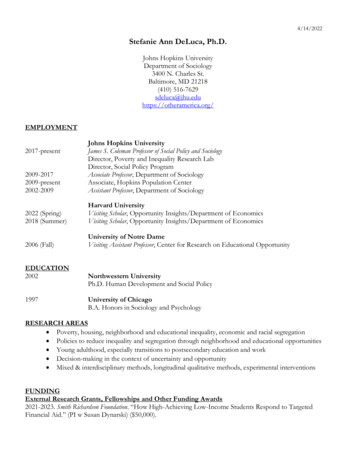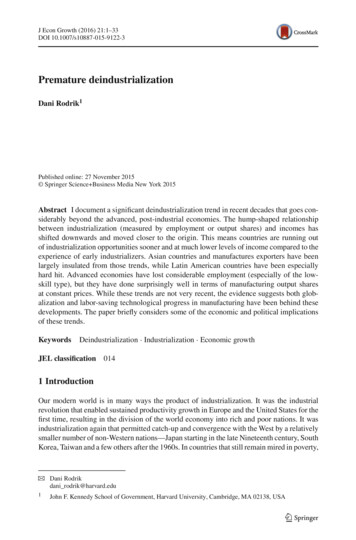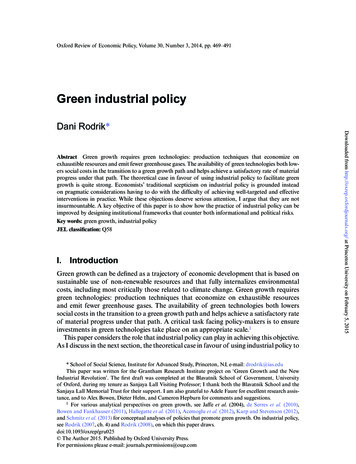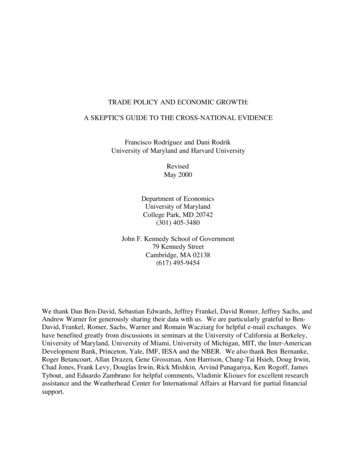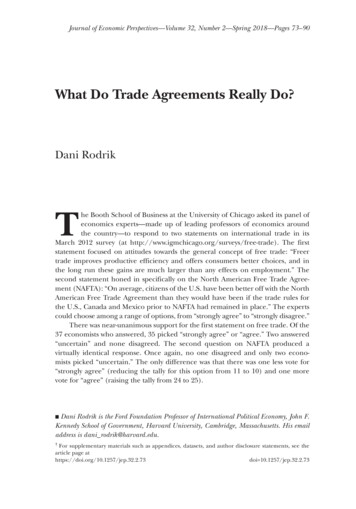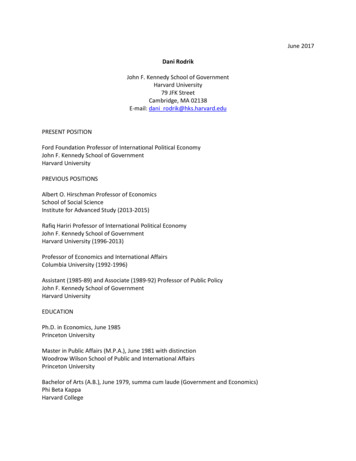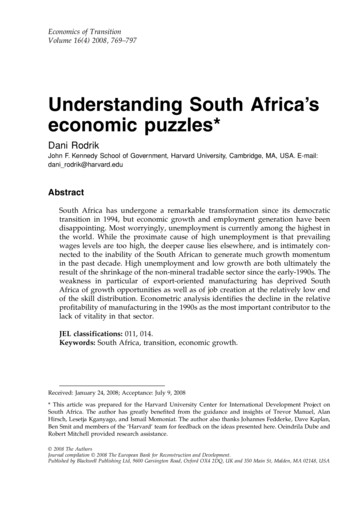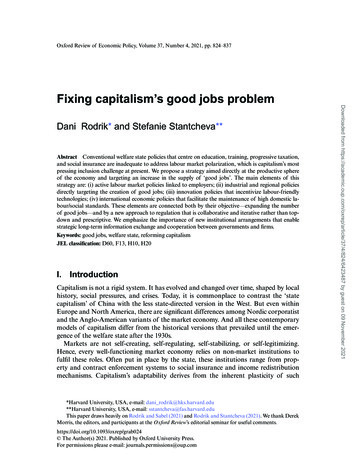
Transcription
Oxford Review of Economic Policy, Volume 37, Number 4, 2021, pp. 824–837Dani Rodrik* and Stefanie Stantcheva**Abstract Conventional welfare state policies that centre on education, training, progressive taxation,and social insurance are inadequate to address labour market polarization, which is capitalism’s mostpressing inclusion challenge at present. We propose a strategy aimed directly at the productive sphereof the economy and targeting an increase in the supply of ‘good jobs’. The main elements of thisstrategy are: (i) active labour market policies linked to employers; (ii) industrial and regional policiesdirectly targeting the creation of good jobs; (iii) innovation policies that incentivize labour-friendlytechnologies; (iv) international economic policies that facilitate the maintenance of high domestic labour/social standards. These elements are connected both by their objective—expanding the numberof good jobs—and by a new approach to regulation that is collaborative and iterative rather than topdown and prescriptive. We emphasize the importance of new institutional arrangements that enablestrategic long-term information exchange and cooperation between governments and firms.Keywords: good jobs, welfare state, reforming capitalismJEL classification: D60, F13, H10, H20I.IntroductionCapitalism is not a rigid system. It has evolved and changed over time, shaped by localhistory, social pressures, and crises. Today, it is commonplace to contrast the ‘statecapitalism’ of China with the less state-directed version in the West. But even withinEurope and North America, there are significant differences among Nordic corporatistand the Anglo-American variants of the market economy. And all these contemporarymodels of capitalism differ from the historical versions that prevailed until the emergence of the welfare state after the 1930s.Markets are not self-creating, self-regulating, self-stabilizing, or self-legitimizing.Hence, every well-functioning market economy relies on non-market institutions tofulfil these roles. Often put in place by the state, these institutions range from property and contract enforcement systems to social insurance and income redistributionmechanisms. Capitalism’s adaptability derives from the inherent plasticity of such*Harvard University, USA, e-mail: dani rodrik@hks.harvard.edu**Harvard University, USA, e-mail: sstantcheva@fas.harvard.eduThis paper draws heavily on Rodrik and Sabel (2021) and Rodrik and Stantcheva (2021). We thank DerekMorris, the editors, and participants at the Oxford Review’s editorial seminar for useful comments.https://doi.org/10.1093/oxrep/grab024 The Author(s) 2021. Published by Oxford University Press.For permissions please e-mail: journals.permissions@oup.comDownloaded from 23487 by guest on 09 November 2021Fixing capitalism’s good jobs problem
Fixing capitalism’s good jobs problem8251It is useful in this context to consider how China has managed to provide effective property rights incentives and contract enforcement through institutional arrangements that differ greatly from conventionalWestern ones (Rodrik, 1996; Qian, 2017).2 Osterman (2020) provides a very valuable set of case studies on what can be done to increase good jobsin specific industries. See also Ton (2014), who discusses how it may be in many firms’ self-interest to enhancethe quality of the jobs they offer.3 This paper focuses on advanced economies. Many developing economies seemed to have been doingbetter prior to the pandemic, on the back of export-oriented industrializing strategies. However, even beforethe pandemic there were signs that their growth models were running out of steam (see Diao et al., 2019, andRodrik, 2018).Downloaded from 23487 by guest on 09 November 2021arrangements. Even property rights, typically considered the cornerstone of a marketeconomy, can be repackaged and reconfigured in an almost infinite variety of ways.1What counts as property and where its boundaries lie are questions to which there havenot been immutable answers.The malleability of capitalism is its great strength. Crises of capitalism are as old ascapitalism itself. Yet, each time, capitalism has survived, reforming and adapting itselfto new challenges.The two biggest challenges today’s capitalism faces are climate change and socialinclusion. In its own way, each of these two challenges is existential. Climate changethreatens humanity through its potentially catastrophic consequences for our physicalenvironment. The economic, cultural, and spatial divides that have deepened withincountries in recent decades, on the other hand, threaten the viability of our societiesand polities.In this paper, we address the second of these challenges. We argue that the conventional welfare state policies centring on education, training, progressive taxation,and social insurance are on their own inadequate to address today’s inclusion challenge. We propose a multi-pronged strategy aimed directly at the productive sphereof the economy and targeting an increase in the supply of ‘good jobs’—jobs thatprovide a middle-class living standard, a sufficiently high wage, good benefits, reasonable levels of personal autonomy, adequate economic security, and career ladders.2The main elements of this strategy are: (i) active labour market policies linked toemployers; (ii) industrial and regional policies directly targeting the creation of goodjobs; (iii) innovation policies that incentivize labour-friendly technologies; (iv) international economic policies that facilitate the maintenance of high domestic labour/social standards.These elements are connected both by their objective—expanding the number ofgood jobs—and by a new approach to regulation that is collaborative and iterativerather than top-down and prescriptive. We emphasize the importance of new institutional arrangements that enable strategic long-term information exchange and cooperation between governments and firms (as well as between the general public andpolicy-makers)—underscoring the need for joint endeavour by public, private, andcivic sectors to deliver improvements for all. In the rest of the paper, we discuss thisapproach and illustrate it in the context of the four specific elements of the good-jobsstrategy.3
826II.Dani Rodrik and Stefanie StantchevaStating the problem and the general approachFigure 1: Labour market polarizationSource: OECD (2019).Downloaded from 23487 by guest on 09 November 2021One of the fundamental problems of contemporary capitalism is its failure to produceadequate numbers of good jobs to sustain a prosperous and growing middle class.Quantitative indicators of this can be found in measures of labour market polarization, rising spatial inequality, declining job stability, greater self-reported economic insecurity, and declining middle-class income shares (Autor and Dorn, 2013; Eurofound,2017; OECD, 2019). Figure 1 shows the collapse in the number of jobs for medium-skilloccupations in leading advanced economies. This figure is taken from OECD (2019)and similar results can be found in studies by Autor et al. (2020) and McKinsey GlobalInstitute (2020). Even in countries (such as France) where there does not seem to havebeen a marked deterioration in overall inequality, these labour market syndromes areacutely felt (Rodrik and Stantcheva, 2021).The disappearance of good jobs is not just an equity problem. It is a broader socialproblem since declining labour market opportunities produce a wide variety of socialills such as family breakdown, crime, and substance abuse (Case and Deaton, 2020). Itis also a political problem as it fosters the rise of authoritarian and nativist populism(Rodrik, 2021). It is even a problem for economic efficiency and growth insofar as itslows down the dissemination of innovation from the more advanced sectors and firmsto the rest of the economy through the creation of more productive jobs in the middleof the skill distribution.How should we deal with this problem? It is useful to consider our options with thehelp of a matrix that categorizes different types of remedies for inequality (Figure 2).First, we divide policies into pre-production, production, and post-production stageinterventions. For our purposes, this is a better categorization of policies than the moreconventional pre-distribution versus redistribution distinction. It distinguishes betweenpolicies that affect endowments people bring to markets (such as education and skills)and policies that influence production, employment, and investment decisions (such as
Fixing capitalism’s good jobs problem827Figure 2: Remedies for inequalityindustrial policies or labour-market regulations). Second, we divide interventions intothose that intend to redress inequities at the bottom, middle, or top of the income distribution. Minimum wages, for example, target the incomes of the working poor, whilewealth taxes target those at the very top. It is possible to fill all nine cells of the tablewith examples of contemporary policies, as is done in Figure 2.The matrix clarifies the differences between alternative approaches to equity and inclusion. The current policy discussion in the US, for example, focuses almost exclusivelyon the first and third rows of the matrix: how to address poverty at the bottom andconcentration of income at the very top. The traditional welfare state model operateslargely within the first and third columns, too: it targets the educational and other endowments of workers before they join labour markets on the one hand and ex post redistribution through taxes and social insurance policies on the other. The government’srole is to finance education, engage in progressive taxation, and provide social insurance against idiosyncratic risks such as unemployment, illness, and disability. In eithercase, the assumption is that good middle-class jobs will be available to all with adequateeducation and skills.We need a different—or at least complementary—approach when inequality andeconomic insecurity are structural problems, and when the inadequacy of good middleclass jobs is driven by secular trends such as technology and globalization. Preparingyoung workers for the labour market and reskilling older workers for newer occupations will not work if firms are not supplying an adequate quantity of good jobs. Thiscalls for targeting the middle cell of the matrix, focusing on direct interventions in theproductive sphere with the goal of expanding the supply of middle-skill jobs.We discuss what such a good-jobs strategy might look like under four separate headings below. Two points are worth making at the outset. First, good jobs cannot beDownloaded from 23487 by guest on 09 November 2021Notes: UBI is universal basic income. EITC is earned income tax credit.
828Dani Rodrik and Stefanie Stantchevagenerated by fiat; they are contingent on higher productivity and the expansion of goodfirms. The proposed strategy is one that specifically focuses on productivity enhancements along the middle spectrum of the labour market. Second, the strategy requiresan approach to governance and regulation that differs from the standard ex ante, arm’slength model that is familiar to economists. We elaborate on that governance modelafter discussing the specific elements of the strategy.Active labour market policies are programmes that aim to increase the beneficiaries’prospect of finding employment or increasing earnings. European programmes in thisdomain include skills training and certification, employment subsidies, public-sectoremployment, and assistance with job search. Studies on their impacts have generallyyielded mixed results (Caliendo and Schmidl, 2016). However, a particular approach toskills training, called ‘sectoral training programs’ in the US, has produced much moreencouraging results.Sectoral programmes differ from general training courses in that they are oriented towards the need of particular employers and require much greater cooperation with them.They also provide a wider range of customized services to job-seekers. Exemplified byProject Quest in San Antonio, Texas, they entail: training in soft skills as well as occupation-specific skills and credentials; partnerships with community colleges and employers;extensive wraparound and follow-up services in addition to training and job placement;and a dual-customer approach that involves employers as well as job-seekers. Sectoraltraining programmes have been evaluated repeatedly through randomized methods andhave been shown to produce significant and sustained gains for participants (Maguireet al., 2010; Schaberg, 2017; Roder and Elliott, 2019; Katz et al., 2020).Key to their success is their targeting of specific industries or occupations that havethe potential to create more local employment. Programme staff work closely withemployers, and the firms themselves may serve on the programmes’ boards. Trainingcourses are designed in close cooperation with prospective employers. Strong links withlabour unions and local governments help, too, as these provide additional vehiclesthrough which workers can be placed. As the relationship develops, employers start tosee these programmes as an important asset. Since firms benefit from the training, theyare willing to cooperate with the programme and sometimes even adjust their employment practices. Increased trust between employers and training agencies can pay off inthe form of higher productivity for the firm as well as increased labour market opportunities for job-seekers.Despite their success, such programmes have remained very small and limited inscope.4 In the US, they are associated with non-governmental civic or community organizations rather than state agencies. In Europe, there are extensive networks of PublicEmployment Services (PES) which, however, typically operate at arm’s length from employers and provide limited services to workers. More recently, some PES (in Germanyand Sweden, for example) have experimented with greater employer-orientation.4 President Biden’s infrastructure plan commits federal resources to scaling up sectoral training programmes, and is an important first step.Downloaded from 23487 by guest on 09 November 2021III. Active labour market policies linked to employers
Fixing capitalism’s good jobs problem829IV. Industrial and regional policies targeting the creationof good jobsDespite economists’ apparent aversion to ‘industrial policies’, the latter have alwaysbeen part of most governments’ arsenals, simply changing shape and focus (and, sometimes, just names) as economic priorities and fashions evolved. In the US, the practiceof industrial policy has a long history, even if the term has carried a note of disreputeuntil very recently. It has taken a wide range of forms—from the Defense AdvancedResearch Projects Agency (DARPA) to Small Business Administration programmes, towidespread state-level business incentives. In Europe, even though state aid is generallyfrowned upon, investment incentives for small businesses and lagging regions remainrampant. In recent years, the need for industrial policy has been articulated more explicitly and forcefully. The challenges of transition to a green economy, geographicdivides, digitalization, and the perceived threat of Chinese competition in high-techindustries have highlighted the urgency of public action to stimulate investment andinnovation in particular industries and regions.While employment creation is almost always a subsidiary goal of these programmes,industrial incentives are rarely designed around the imperative of good jobs. For example, in what is one of the best studies of industrial policy, a paper by Criscuolo et al.(2019) analyses the effects of the Regional Selective Assistance (RSA) programme inBritain. The programme aimed to maintain and expand employment in low-income,high-unemployment areas, but was essentially a subsidy to capital. Firms could applyto the government with specific investment plans, either to finance new capital equipment or to modernize existing plants. If approved, the government financed up to 35per cent of the investment. The programme did have a significant effect on employmentin smaller firms according to Criscuolo et al. (2019), but it did not directly subsidizegood jobs or other activities that may have had a more direct impact on jobs.Downloaded from 23487 by guest on 09 November 2021There is an opportunity to enhance training and active labour market policies bytransforming them into vehicles of sustained engagement and collaboration with local(and prospective) employers. The provision of customized services to both job-seekersand employers can help achieve multiple objectives. It makes training and job placement more effective. It makes it possible to reach workers who might otherwise dropout of the labour market because of particular circumstances (such as lack of transport, child care, or specific gaps in education). It might not only enhance the productivity of local firms through qualified employees, but also induce them to adapt theiremployment and human resources practices to the needs of local labour markets.Ultimately, the full quid pro quo—more good jobs in return for more good workers—can be realized only when businesses recognize the benefits of the services providedto them by public-sector training and placement agencies. Therefore, moving beyondplacement to productivity requires not just the right institutional designs but also a process of building trust among social partners—employers, workers’ organizations, andpublic agencies such as the PES. Developing the requisite social capital will necessarilytake time. It will also require complementary interventions in the areas of industrialand innovation policies, to which we turn next.
830Dani Rodrik and Stefanie StantchevaDownloaded from 23487 by guest on 09 November 2021A second consideration is that business incentives work best when they are customized and targeted to specific needs of firms, and when they are part of an iterative dialogue between firms and government agencies. The traditional caricature of industrialpolicy, in which bureaucrats choose a set of economic activities to be promoted, selectpre-determined incentives (e.g. tax rebates or subsidized credit), and then impose hardconditionality on the receiving firms does not accurately characterize how industrialpolicy was actually implemented in Japan, Taiwan, South Korea, or China. Successfulprogrammes tend to revolve around a process of strategic collaboration, in which firms’needs, market opportunities, and appropriate remedies are discovered over time, withpolicies revised as learning takes place.Tim Bartik of the Upjohn Institute has been a long-term observer of business incentives in the US, and his synthesis of the evidence provides a valuable perspective that canapply equally well to other contexts (Bartik, 2019, 2020). The current approach revolveslargely around significant tax breaks that often go to large corporations and are notproperly targeted or designed. They also involve a very large cost per job created. Bartikmakes several recommendations. First, business incentives should focus on areas thatare distressed—i.e. areas that truly need them. Second, the incentives should focus onsectors or firms that are likely to have high job creation potential. Third, public assistance should focus less on tax incentives (and on encouraging physical investment) andmore on specific public services needed by firms, such as customized business services,zoning or infrastructure policies, local amenities, and skills training. Fourth, businessassistance should be viewed as a portfolio of services rather than a particular incentive,with the actual mix attuned to local conditions.Bartik’s recommendations echo ideas that have developed over the last couple ofdecades into a new conception of industrial policy (Evans, 1995; Rodrik, 2007, 2008;Sabel, 2007; Hausmann et al., 2008; Fernández-Arias et al., 2016; Ghezzi, 2017). Underthis conception, the government is not presumed to know where the market failures arebeforehand and, therefore, does not determine ex ante what the specific policy instruments are. Industrial strategy consists of a collaborative process of ‘discovery’ involvingbusiness and agencies of the state, where the objective is to identify the constraints andopportunities over time, and to design interventions appropriately. As learning takesplace, policies are revised, refined, and sometimes reversed. We know such practices arefeasible because they already exist in a number of policy domains; Rodrik and Sabel(2021) discuss water-quality regulation in Europe and promotion of high-tech innovation through DARPA in the US, while Ghezzi (2017) discusses their application tomodern agriculture in Peru.In return for services provided by state agencies, firms would be asked to make provisional commitments on specific quantities of jobs they will create at different qualification levels (i.e. low salaried employees, medium-salaried employees, etc.). Firms wouldbe encouraged to pool proposals when they make use of common inputs—as wouldbe the case for workers with particular skills or infrastructure. Other conditionalitiesmight be included as well. A firm might be asked to work with local suppliers to improve their management or technological capabilities. Or a firm that is considering outsourcing part of its production to a foreign country may be asked to delay doing so fora number of years, in case productivity improvements at home may render those plansunnecessary. The firm may be required to arrange for additional training for some ofits employees.
Fixing capitalism’s good jobs problem831A particular objective would be to connect business incentives more tightly with thekind of labour market and training programmes discussed previously. While labourmarket interventions may do a good job of preparing job-seekers for good jobs, theireffects will remain limited if there is not a corresponding increase in the supply of goodfirms and of good jobs in existing firms.In 2016 Elon Musk announced that Tesla’s Model 3 would be built in a new, fully automated car factory. Codenamed ‘Alien Dreadnought’, the project would allow robots inthe factory to operate beyond human speed, with raw materials coming in at one endand finished cars rolling out the other. By mid-2018 it was clear that automation wasnot working as expected and Tesla was driven close to financial collapse. The companywas forced to launch a new assembly line full of human workers. Musk would say later:‘people are way better at dealing with unexpected circumstances than robots.’5 ‘Yes, excessive automation at Tesla was a mistake. . . . Humans are under-rated,’ he concededon Twitter.Tesla’s automation mistake is revealing for several reasons. First, it highlights howproduction techniques relying on human labour can still dominate automation when itis impossible to fully account for uncertainty and routinize all tasks. Second, it is indicative of the excessive faith many business leaders often place on new technologies. Third,it reminds us that technology adoption is a choice: businesses face a range of optionsabout what kind of innovations to use and deploy—choices that have significant implications for the workforce—and sometimes, society as a whole—but are not typicallyinternalized in the decision-making process.The usual discussion around the labour market implications of new technologies is curiously one-sided. The direction of technological change—whether it augments or replaceslabour—is taken to be essentially pre-determined and out of our control. It is workers andsociety at large that have to adjust to technological change—rather than the other wayaround. But as the late Anthony Atkinson emphasized, the determination of the direction oftechnological change cannot be left to firms and innovators alone (Atkinson, 2015, pp. 115–18). This argument has been picked up more recently by Daron Acemoglu (Acemoglu andRestrepo, 2019) (see also Korinek (2019) and Rodrik and Stantcheva (2021)).The direction of technological change depends on several conditions that may beamenable to policy influence. First and most directly, government-funded and -directedinnovation programmes make decisions about what kind of innovations to promote.Defence-related and green technologies are examples. Employment-friendly technologies—those that augment rather than replace labour—could be part of those priorities,though they are not at present. Second, private-sector innovation incentives can beskewed because of prevailing financing methods or policies. Venture capital, for example, naturally seeks areas where the returns can be capitalized relatively quickly Downloaded from 23487 by guest on 09 November 2021V. Innovation policies that incentivize labour-friendlytechnologies
832Dani Rodrik and Stefanie Stantcheva6 ‘So-so’ technologies are those that substitute labour, but are not that much more productive at the taskthan workers are, thus not increasing productivity sufficiently.Downloaded from 23487 by guest on 09 November 2021investors. This may exclude innovations where the gains are longer term or reaped bysociety at large (Lerner and Nanda, 2020).Third, most advanced economies tax capital income more lightly (through depreciation allowances and various incentives of the type we discussed previously) and taxlabour more heavily (through personal income taxes, social insurance contributions,and payroll taxes). An unintended consequence of such a tax system is to make it moreattractive to firms to economize on labour by investing in machinery, to an extent thatmay be socially suboptimal (Acemoglu et al., 2020).Finally, the direction of technological change also depends on the balance of powerbetween employers and employees. When workers have a say in the workplace, management has to get buy-in from them before major technologies are deployed and work isrestructured. This can result in a modern version of Luddism—aversion to any kind ofinnovation that appears to threaten jobs. But it can also be a useful counterweight toadverse incentives in the system encouraging too much automation or the adoption ofwhat Acemoglu et al. (2020) call ‘so-so’ technologies.6 In short, the direction of technical change, in addition to its rate, depends on a wide range of factors, many of whichcould be influenced by societal and governmental decision-making.As a matter of logic, the gap between skills and technology can be closed in one oftwo ways: either by increasing education to match the demands of new technologies,or by redirecting innovation to match the skills of the current (and prospective) labourforce. The second strategy, which gets practically no attention in policy discussions, isworth taking seriously. It may be possible to direct technology to better serve the existing workforce’s needs, in addition to preparing the workforce to match the requirements of technology.Acemoglu and Restrepo (2018) have argued that it is possible to countervail presenttechnological trends and push innovation in a direction that creates new, labour-augmenting tasks. They cite three areas. First, they suggest artificial intelligence (AI) couldbe used in education in order to create more specialized tasks for teachers, personalizeinstruction for students, and increase effectiveness of schooling in the process. Second,they note a similar potential in healthcare, which is perhaps closer to realization. AItools can significantly enhance the diagnostic and treatment capabilities of nurses, physicians’ aides, and other medical technicians, allowing a priori ‘less skilled’ practitionersto perform tasks that only physicians with many more years of professional education have traditionally undertaken. Third, Acemoglu and Restrepo (2018) mention theuse of augmented and virtual reality technologies in manufacturing, enabling humansand robots to work together in performing precision tasks (rather than the latter replacing the former). Such technologies are based on smaller, more nimble robots thatalso enable greater customization of production in response to specific customer needs.Indeed, companies such as BMW and Mercedes are building their automation plansaround human work, which they have found allows both for greater reliability and morecustomization in production.These considerations suggest some broad directions for policy. Prevailing fiscal regimes can be reviewed to ascertain whether there are excessive incentives for investment
Fixing capitalism’s good jobs problem833VI. International economic policies that safeguard highdomestic labour/social standardsAre the policies of the sort we have discussed here that induce domestic firms to expandgood jobs feasible in a globalized economy? What if firms evade domestic responsibilities by outsourcing, hiding in tax shelters, or if they lose competitiveness and marketshare to firms in countries with lower standards? The principal safeguard against sucha race to the bottom is that the good-jobs strategy is as much about enhancing productivity—especially for lagging firms—as it is about jobs. It recognizes that good jobsrequire good firms. Enhanced productivity makes domestic firms better at global competition and should reduce i
strategy are: (i) active labour market policies linked to employers; (ii) industrial and regional policies directly targeting the creation of good jobs; (iii) innovation policies that incentivize labour-friendly technologies; (iv) international economic policies that facilitate the maintenance of high domestic la-bour/social standards.

